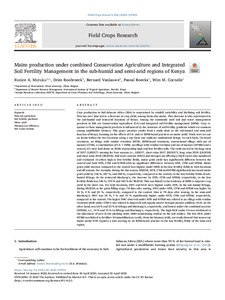| dc.identifier.citation | Mutuku, E.A., Roobroeck, D., Vanlauwe, B., Boeckx, P. & Cornelis, W.M. (2020). Maize production under combined conservation agriculture and integrated soil fertility management in the sub-humid and semi-arid regions of Kenya. Field Crops Research, 254: 107833,1-15. |
| dc.description.abstract | Crop production in Sub-Saharan Africa (SSA) is constrained by rainfall variability and declining soil fertility. This has over time led to a decrease in crop yield, among them also maize. This decrease is also experienced in the sub-humid and semi-arid locations of Kenya. Among the commonly used soil and water management practices in SSA are Conservation Agriculture (CA) and integrated soil fertility management (ISFM). Crop response to these management practices is influenced by the existence of soil fertility gradients which are common among smallholder farmers. This paper presents results from a study done in the sub-humid and semi-arid location of Kenya, focusing on the effects of CA- and/or ISFM-based practices on maize yield. Trials were set out on farms within the two locations using a one farm one replicate randomized design. In each farm, CA-based treatment, no tillage with residue retention (NTR), ISFM-based treatment, conventional tillage with use of manure (CTM), a combination of CA + ISFM, no tillage with residue retention and use of manure (NTRM) and a control, (C) were laid down on fields representing high and low fertility soils. The trials started in the long rains of 2017 (LR2017) running for four seasons i.e., LR2017, short rains 2017 (SR2017), long rains 2018 (LR2018) and short rains 2018 (SR2018). Soil water content (SWC) and nitrogen use efficiency (NUE) were also monitored and evaluated. In either high or low fertility fields, maize grain yield was significantly different between the control and both NTR, CTM and NTRM with no significant differences between NTR, CTM and NTRM. Maize grain yield increase compared to the control was highest under ISFM in the low fertility fields in both locations and all seasons. For example, during the last season, SR2018, NTR, CTM and NTRM significantly increased maize grain yield by 136 %, 297 %, and 208 %, respectively, compared to the control, in the low fertility fields of sub-humid Kibugu. In the semi-arid Machang’a, the increase by NTR, CTM and NTRM, respectively, in the low fertility fields was 146 %, 379 % and 183 % for SR2018. This was linked to the tendency of ISFM to improve crop yield in the short run. For both locations, SWC and NUE were highest under NTR. In the sub-humid Kibugu, during SR2018, at the grain filling stage, 78 days after sowing, SWC under NTR, CTM and NTRM was higher by 16 %, 9 % and 20 %, respectively, compared to the control. Also at 78 days after sowing, in the semi-arid Machang’a, SWC was 18 %, 7 % and 15 % significantly higher under NTR, CTM and NTRM, respectively, compared to the control. The higher SWC observed under NTR and NTRM was related to no tillage with residue retention while under CTM it was related to improved soil organic matter through manure addition. NUE, on the other hand, was 26 % and 23 % in Kibugu and Machang’a, respectively, and lowest under the combined practice (NTRM), i.e., 19 % and 15 % in Kibugu and Machang’a, respectively. The high NUE under CA was attributed to the placement of urea in the planting holes while maintaining residue on the soil surface. The low NUE under NTRM was linked to fertilizer N immobilization. Lastly, from the biomass yield, our study showed that monocrop maize under NTR requires a kick-starting by an ISFM-based practice in the low fertility fields of the semi-arid region. |

